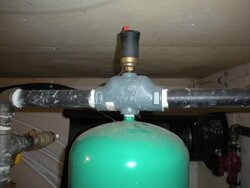The EKO 60 is live but even after reading everything on the site, I am stuck. When I filled the boiler with water I used a hose attached to a T with a ball valve in the primary loop. This was a temporary situation as I plan to install a plumbed-in water feed this weekend.
The pressure was about 25 when full. I was concerned about that high pressure since the pressure relief valve is set for 30. Not much room there for expansion.
Thursday I learned about a Watts feed water pressure regulator and purchased one yesterday. I installed it last night on the same T as before (a more permanent install requires that I shut down and de-pressurize the system) . Following the instructions for the regulator, I turned the adjusting screw counter clockwise to reduce the pressure. Nothing, the pressure stayed the same.
Is it necessary to drain the entire system and re-add water through this valve. What is the secret to getting a bubble-free low pressure system. Ideally, I'd like to run with 10 lbs.
BTW, I filled the boiler with wood this morning and have just experienced a blow-off of the system pressure relief valve (30 PSI). Oh well, I at least I know it works, but it has created a small mess. Guess I was right to be concerned about the starting pressure.
I had set the controller for 70 and the LED reads 83 after the "blow-off". The circs are running and everything appears normal except for the large wet area. Is it normal for the temperature to exceed the controller setting? I read the user manual, but there is no answer there.
The pressure was about 25 when full. I was concerned about that high pressure since the pressure relief valve is set for 30. Not much room there for expansion.
Thursday I learned about a Watts feed water pressure regulator and purchased one yesterday. I installed it last night on the same T as before (a more permanent install requires that I shut down and de-pressurize the system) . Following the instructions for the regulator, I turned the adjusting screw counter clockwise to reduce the pressure. Nothing, the pressure stayed the same.
Is it necessary to drain the entire system and re-add water through this valve. What is the secret to getting a bubble-free low pressure system. Ideally, I'd like to run with 10 lbs.
BTW, I filled the boiler with wood this morning and have just experienced a blow-off of the system pressure relief valve (30 PSI). Oh well, I at least I know it works, but it has created a small mess. Guess I was right to be concerned about the starting pressure.
I had set the controller for 70 and the LED reads 83 after the "blow-off". The circs are running and everything appears normal except for the large wet area. Is it normal for the temperature to exceed the controller setting? I read the user manual, but there is no answer there.



